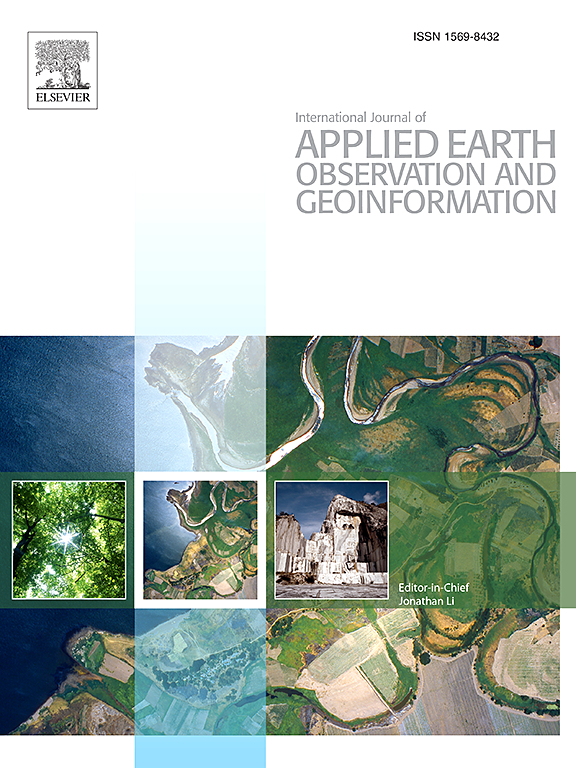Assessing change point detection methods to enable robust detection of early stage Artisanal and Small-Scale mining (ASM) in the tropics using Sentinel-1 time series data
IF 7.6
Q1 REMOTE SENSING
International journal of applied earth observation and geoinformation : ITC journal
Pub Date : 2025-04-09
DOI:10.1016/j.jag.2025.104525
引用次数: 0
Abstract
Artisanal and Small-Scale mining (ASM) provides essential livelihoods for many in developing countries but often lacks regulation, leading to environmental issues such as water pollution and deforestation. Timely and accurate mapping of ASM activities is vital for responsible mining that benefits the environment and local communities. Synthetic Aperture Radar (SAR) is crucial for regular ASM monitoring in cloudy regions due to its ability to penetrate clouds. However, atmospheric effects can limit its effectiveness, particularly with shorter wavelengths in wet tropical areas during the rainy season. This study utilised a time series smoothing technique to improve Sentinel-1 (S-1) SAR time series data, reducing SAR noise and atmospheric effects from heavy rainfall for early ASM activity detection. We tested three change point detection (CPD) methods, including cumulative sum (CuSuM), pruned exact linear time (PELT), and binary segmentation (BinSeg) in the Western and Ashanti wet regions in southern Ghana using the smoothed S-1 data for early ASM detection. We observed a relatively fast response of ASM activity tracking when utilising smoothed S-1 data at both sites for VV and VH polarizations during the rainy seasons. However, VH polarization is more effective than VV polarization during rainy seasons. While all CPD algorithms showed similar performance, CuSuM had the shortest lag time of up to 9 days, compared to 11 days for PELT and BinSeg. This method significantly reduces ambiguity caused by heavy rainfall when identifying change points due to ASM activity, making it a viable option for near real-time monitoring in wet tropical regions.

利用Sentinel-1时间序列数据评估变化点检测方法,以实现对热带地区早期手工和小规模采矿(ASM)的稳健检测
手工和小规模采矿为发展中国家的许多人提供了必要的生计,但往往缺乏监管,导致水污染和森林砍伐等环境问题。及时和准确地绘制ASM活动地图对于负责任的采矿至关重要,这有利于环境和当地社区。合成孔径雷达(SAR)具有穿透云层的能力,对多云地区的常规ASM监测至关重要。然而,大气影响会限制其有效性,特别是在雨季潮湿的热带地区,波长较短。本研究利用时间序列平滑技术改进Sentinel-1 (S-1) SAR时间序列数据,降低SAR噪声和强降雨对早期ASM活动的大气影响。我们测试了三种变化点检测(CPD)方法,包括累积和(CuSuM),裁剪精确线性时间(PELT)和二值分割(BinSeg)在加纳南部的西部和阿散蒂潮湿地区,使用平滑的S-1数据进行早期ASM检测。我们观察到,在两个站点使用平滑的S-1数据对雨季的VV和VH极化进行ASM活动跟踪时,响应相对较快。而在雨季,VH极化比VV极化更有效。虽然所有CPD算法都表现出相似的性能,但CuSuM的延迟时间最短,为9天,而PELT和BinSeg的延迟时间为11天。该方法在识别ASM活动引起的变化点时显著减少了暴雨造成的模糊性,使其成为潮湿热带地区近实时监测的可行选择。
本文章由计算机程序翻译,如有差异,请以英文原文为准。
求助全文
约1分钟内获得全文
求助全文
来源期刊

International journal of applied earth observation and geoinformation : ITC journal
Global and Planetary Change, Management, Monitoring, Policy and Law, Earth-Surface Processes, Computers in Earth Sciences
CiteScore
12.00
自引率
0.00%
发文量
0
审稿时长
77 days
期刊介绍:
The International Journal of Applied Earth Observation and Geoinformation publishes original papers that utilize earth observation data for natural resource and environmental inventory and management. These data primarily originate from remote sensing platforms, including satellites and aircraft, supplemented by surface and subsurface measurements. Addressing natural resources such as forests, agricultural land, soils, and water, as well as environmental concerns like biodiversity, land degradation, and hazards, the journal explores conceptual and data-driven approaches. It covers geoinformation themes like capturing, databasing, visualization, interpretation, data quality, and spatial uncertainty.
 求助内容:
求助内容: 应助结果提醒方式:
应助结果提醒方式:


